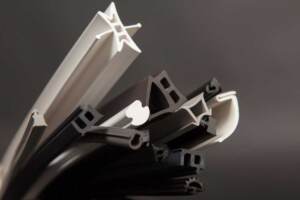Rubber Extrusion Process and Applications

If you’ve partnered with a rubber fabrication company before, you’ve seen how effective this process is for custom-molded parts. What you might not know is that custom rubber extrusion can tackle customized projects like tubing and seals.
Extruded rubber parts are often useful for keeping contaminants out of systems. These components play integral roles across the automotive, marine, aerospace, transportation, healthcare and food processing sectors. An investment in custom rubber extrusion can transform what production looks like for your business.
See below to learn about the basics of the typical rubber extrusion sequence, some common uses for extruded rubber parts and some ways you can benefit from implementing custom-extruded rubber parts in your next project.
What are the Steps of the Rubber Extrusion Process?
To extrude rubber, fabricators feed rubber strips or pellets into a hopper for screws to move into a closed container and undergo heating. The conditions lead the rubber to melt and continue moving through the rotating screws. Next, the material passes through a custom-shaped die to then undergo curing by autoclaving or other methods to form a finished product.
The process can accommodate several rubber materials including silicone, neoprene, Viton, EPDM and nitrile rubber. To get the most out of an investment in custom rubber extrusion, you will need to set aside some time to get to know the environment of your application and your project goals to select the right rubber materials.
Different rubber compounds react differently to substances and stresses. For example, EPDM rubber is notable for its resistance to ozone, while nitrile rubber can withstand significant levels of wear from oils.
To select the right materials, consider how much a specific compound costs per pound, levels of exposure to certain chemicals, necessary tensile strength or viscosity levels, temperature conditions and the necessary function of the component.
Teams can customize dies to form extrusions of a diverse range of profiles. Some examples include square, rectangle, round, half-round, U-channels, T-shaped, E-shaped and P-shaped rubber extrusion profiles.

What Are Some of the Applications of Extruded Rubber Products?
Extruded rubber parts are often essential in the absorption and storing of energy, reduction of vibration and the formation of hoses. Some examples of extruded rubber components include seals for windows and doors, tubing for drains and pressure switches and pump components.
What Are the Advantages of Extruded Rubber Parts?
Some teams choose to implement rubber extrusion because it can accommodate nearly any length and custom shape. Rubber extrusion is also notable for producing minimal quantities of waste and therefore saving money.
If you have been planning on implementing a distinct design and want to make your business more environmentally sustainable, then rubber extrusion may be the ideal fabrication method for your next project.

Reach Out to the Team From Qualiform Today
Why choose Qualiform Rubber Molding for custom rubber extrusion? Companies turn to Qualiform for premier rubber extrusion because of the team’s leading material selection insight, machinery redundancy, rapid turnaround times, capacity to accommodate the tightest of tolerances, commitment to environmental sustainability and leading customer service.
Qualiform has the right material for nearly any project goal. Count on Qualiform for the reliable fabrication of EPDM, natural rubber, neoprene, Viton, butyl, nitrile rubber, thermoplastic elastomers and more.
In addition to industry-leading rubber extrusion capabilities, Qualiform is a go-to resource for rubber to metal bonding, rubber injection molding, rubber transfer molding and rubber compression molding. No matter how complex the design and no matter how difficult a material is to find, you and your team can depend on Qualiform to deliver every time. The company’s three-shift 24-hour production schedule allows for efficient manufacturing for any project.
To get your next customization going, connect with the team from Qualiform. Visit https://qualiformrubbermolding.com/ today to take the next steps.
